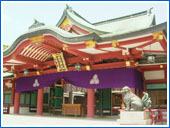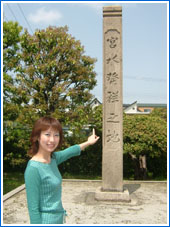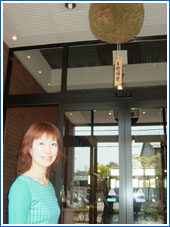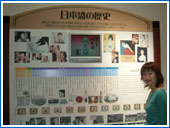
Naruohama Seaside Park is a place to enjoy the fresh scent of the forest near the mouth of Mukogawa River. In the North section there is "Citizen's Forest," a grassy field and "White Ball Forest" an area with commemorative trees planted by high school baseball teams that played in Koshien Stadium Tournament. There are also tennis courts, baseball fields, and an expansive lawn. In the south section with its scent of the sea air, there is a flower garden, a small river for canoes, a terrace near the sea, a park, an outdoor pool, a place for sea fishing, and a sports facility with hot springs baths called "Reso Naruohama." Here people can make use of the large heated indoor and outdoor pool, various types of baths, and a restaurant that overlooks the sea. On the first floor there is a flower studio that introduces an original series of Nishinomiya City. Visitors to this park can enjoy fishing for sardines, mackerel and horse mackerel in the months from April to July; squid, Japanese needlefish, and cutlass fish from August to November; and striped mullet, flounder, and sea bass from December to March.


| Access | Take the Hanshin bus bound for Naruohama from the Koshien Station of the Hanshin Railway, and get off at 'Reso Naruohama'. |
|---|---|
| TEL | 0798-48-9386 |
| Business Hours | April to July 6:00-22:00; August to November 5:00-23:00; December to March 7:00-22:00 |
| Closed | Open all year around except December 29th to January 3rd. |
| Admission Fee for Sea Fishing | 300 yen for adults (from 16 years of age and older); 150 yen for young children (6 to 15 years old) Note: Fishing tackle and bait are not provided |
Completed in 1924, this baseball stadium has a seating capacity of 53,000 people and plays host to the Japanese professional team the Hanshin Tigers. During the year there are approximately 60 official professional games played here before the passionate fans of the Hanshin Tigers. Also, in April and August, this stadium becomes the baseball sanctuary for high school baseball teams with representative teams from each prefecture in Japan coming to Koshien Stadium to enthusiastically compete for the Japanese high school baseball crown. In December, Koshien Stadium is the site for die-hard fans to assemble and cheer for their beloved Japanese university in the final game to determine the Japanese university champion of American football at the Koshien Bowl. Since it was built over 80 years ago, the green ivy covering the exterior walls of the stadium has become a trademark of the Koshien Stadium.
The name "Koshi-en" derives from year of Koshi or 'Kinoene' which denotes 1924 by a base 60 counting system for days, months, and years that was used for divination in ancient China. The first year in this 60-year cycle is believed to be propitious.


| Access | Walk 5 minutes south from the Koshien Stadium Station of the Hanshin Railway. |
|---|---|
| TEL | 0798-47-1041 |
| Business Hours | Ticket office hours 9:00 to 18:00 (Opening day for profession baseball from 10:00) |
| Closed | Mondays, national holidays (it is closed on Sundays and national holidays in December and on Saturdays, Sundays, and national holidays in January and February; subject to change according to stadium events) |
| Admission Fee | 1400 to 3500 yen (for main inquiries) General admission for baseball games is 1400 yen for unreserved seating. (prices may vary according to seating) |
| Parking | None |


Imazu Lighthouse is a ten-minute walk south of the Hanshin Railway Kusugawa Station. Constructed by the Ozeki Sake Brewery in 1810 during the Edo Period as a lighthouse to guide merchant ships and fishing boats in and out of the Imazu Port, the Imazu Lighthouse was reconstructed in 1984. Built on a stand made of stone and standing nearly 6.7 meters, the lighthouse used a wooden frame lamp and a paper shade to beam light onto the sea. At the time it was built, oil was used as fuel, but in the past 90 years it has used electricity for light. It continues even to today as a safety beacon on the seas with its green light. In 1968, the Maritime Safety Agency approved its use as a navigation landmark, and it has continued active service under private lighthouse management with listings in sea charts and lighthouses. It has been designated as an important cultural asset of Nishinomiya City for which the Nishinomiya citizens feel both a sense of pride and nostalgia.


To access the Nishinomiya Battery, take the Hanshin bus from the Hanshin Railway Nishinomiya Station and get off at Nishihato-cho. It is five minutes on foot. Batteries were built in Imazu, Nishinomiya, Wada Cape, and Maiko in the last days of the warship magistrate by Katsu Kaishu to strengthen the coastal defense. The Nishinomiya Battery was completed in 1866, taking four and half years to complete, and is a 3-layer circular structure made of stone with an inside diameter of approximately 17 meters and a height of about 12 meters. The wall thickness is 1.2 meters (1st floor bottom 1.5 meters). On the 2nd floor, there were 11 cannon openings that allowed 2 cannons to be directed and fired in four directions and one window. It was said that just testing firing caused a billet of smoke rendering it almost unusable, and it wasn't used during the Meiji Restoration. In 1884 a fire damaged the wooden part but visitors can still get a glimpse of the societal conditions during the last days of the shogunate. Currently it is maintained as a Japanese historical site.

This is one of the largest yacht harbors in Western Japan and can accommodate approximately 700 yachts and boats. With the many white yachts floating on the blue seas, there is a feeling of a Mediterranean resort. Visitors can relax all day sitting on the wooden deck or in the open space of the lawn and feel the misty breeze of the sea blowing on their faces until the sun begins slipping behind the mountains of the Mt. Rokko Mountain Range. As dusk falls to night, the silhouettes of the yachts can be seen illuminating around the piers to create the perfect romantic mood. Inside the Center House, there is a restaurant and a shop for marine goods along with the "Mini Mermaid" the world's smallest yacht to cross the Pacific Ocean and was captained by Kenichi Horie, the famous Japanese mariner.


| Access | Take the Hanshin bus bound for Marina Park from the JR/Hanshin Railway Nishinomiya Station and get off at Yacht Harbor. |
|---|---|
| TEL | 0798-33-0651 |
| Business Hours | 9:30 to 17:00, restaurant 8:30 to 20:00 (weekdays from 10:30) |
| Closed | Tuesday (closed on following day when a national holiday falls on Tuesday) |
| Admission Fee | None |
| Parking | 30 minutes free when using yacht facilities |

The Nishinomiya Shell Museum is located near the Nishinomiya Yacht Harbor in a building designed by the architect Tadao Ando and constructed in the image of a sail being blown in the wind. This building is a natural science museum for the world's shellfish along with valuable research data compiled by the late professor and founder of the Malacological Society of Japan, Tokubei Kuroda. From the 200kg Giant Clam to the smallest shell no bigger than a sesame grain, there are 5,000 shell specimens out of 2000 shellfish varieties in the world on display with a total of 40,000 shell specimens in stock. There is a class for using shells in accessories (advanced reservations are necessary) and concerts held in the spring and autumn inside the museum. Visitors to the museum can learn about the mysterious world of Nautilus shellfish and other shellfish by observing them live in a natural environment complete with rocky beach and sand.


| Access | Take the Hanshin bus bound for the Marina Park from the JR/Hanshin Railway Nishinomiya Station and get off at Marina Park South. |
|---|---|
| TEL | 0798-33-4888 |
| Business Hours | 10:00 to 17:00 (Admission until 16:30) |
| Closed | Wednesday (on following day when Wednesday is a national holiday; opened every day from July 20 to the end of August) |
| Admission Fee | 200 yen for adults, 100 yen for elementary and junior high school students |
| Parking | 3 spaces (free of charge) |


Familiarly called Ebessan for the god of wealth, this shrine is in charge of all the Ebisu Shrines around Japan worshipping Ebisu. The most famous festival "Toka (Jan 10th)-Ebisu" is held every year from January 9th to 11th. Over 1 million people visit the Nishinomiya Shrine to ask for prosperity in commerce during this 3-day festival. Also, on June 14th, there is a "Yukata Festival associated with Ebisu which always is bustling with people.
This shrine is particularly noted from ancient times with its association with Nada-gogo, an area famous for superiorly brewed Japanese sake and with a recording approximately 800 years ago of an offering to the shrine by former emperor Takakura. Especially from Muromachi Period (14th to 16th century), the Ebisu God became the representative of god of prosperity, and Nishinomiya Shrine became the means for spreading the entertainment arts such as puppet show, Noh songs, and Noh parodies throughout Japan. The large front gate, popularly called red gate for its vivid red color, is said to be a donation from Toyotomi Hideyori, the son of Hideyoshi. It has been designated an important cultural asset as one of the grand constructions performed during the Momoyama Period (1568-1600).

| Access | Walk 5 minutes south from the Hanshin Railway Nishinomiya Station. |
|---|---|
| TEL | 0798-33-0321 |
| Hours | 5:00-18:00 (March to October until 19:00) |
| Parking | 70 parking spaces (free of charge) |


To access the Miyamizu Well, walk approximately 10 minutes and there will a number of Miyamizu wells lined up between the Hanshin Expressway and the transportation park. The famous water of Nishinomiya selected among Japan's 100 most famous waters is called Miyamizu. Miyamizu flows underground from the Mt. Rokko Mountain Range primarily over a bedrock of granite filtering the water of its iron content and enhancing mineral content with phosphorus, calcium, and potassium carbonate. Also, its proximity to the sea adds a slight salt content. These minerals enhance yeast fermentation during sake brewing and help to preserve the integrity of the sake.
Miyamizu gushes forth only in a narrow range at an area that used to be covered by the sea. This place is called the "Miyamizu Belt." Each brewery has its own Miyamizu well, and it is necessary to make an appointment beforehand when wanting to take a tour. Only the Ume Tree Well in the Miyamizu development area can be seen freely but the well is surrounded by a rock wall and capped off. Drinking water from any of the wells is strictly prohibited. Within the grounds the wells owned by brewery companies are systematically aligned and have been covered with gravel inside the park. Each well has a half spherical modern mirrored top, and there is a dignified atmosphere. At night it is lit up.

"Nihon Sakari" started brewing sake in 1889, and the "Renga-kan" Sake Museum was reconstructed in brick as was commonly seen at the time. Starting with the sake corner for tasting the rarely available undiluted sake such as freshly brewed sake and top quality brewed sake, there are a number of activities allowing you to experience the attraction of sake such as a Japanese restaurant specializing in delicious food and sake such as udon noodles flavored with Japanese sake, a corner for trial use of rice bran cosmetics, every kind of facilities such as a glassware studio that can make handmade utensils for sake and food. You can even watch a computer-generated simulation of sake being brewed and have a sake tasting to receive a certification of a virtual sake veteran brewer. At a shop for specially selected products, there is a collection of popular freshly brewed sake. As you try the various kinds of sake at the tasting corner, you will realize the richness of Japanese sake and want to share Japanese sake culture with all those around.


| Access | Walk 15 minutes east from the south exit of the Hanshin Railway Nishinomiya Station along Sakagura-dori. |
|---|---|
| TEL | 0798-32-2525 |
| Business Hours | 10:00 to 22:00 (reception desk to 20:30, store until 20:00) |
| Appointment | Only the tour of Sakagura brewery requires an appointment |
| Closed | Second and third Wednesday each month and from December 31st to January 1st |
| Admission Fee | Free of charge |
| Parking | 30 spaces (free of charge) |

Celebrating its 320th year of the refined sake "Hakushika (White Deer)", Tatsuuma-Honke Brewing Co., Ltd. established the Hakushika Memorial Museum of Sake in 1982. Although the Sakagura-kan Museum was completely destroyed in the Great Kobe Earthquake, the ruins left from the 1869 structure were used to reconstruct the sake museum.
The building can be said to contain two parts: "Sakagura-kan," which shows the steps in brewing sake, and "Memorial Hall," which contains the "sake materials room" and the Shintaro Sasabe's cherry-tree materials room. In the sake materials room, there are archives with literature related to drinking sake and fine art sake artifacts introducing sake culture and sake distribution with various exhibitions throughout the year. In the Sakagura-kan, there is a corner that you can touch the tools used for making sake and a corner where you can enter a large tub and hear the sound of bubbling and other sounds as well as see the ruins to investigate the excavation of such things as the marks from the tank placement and marks for placing the kettle used to steam the sake-type rice along with tools for making sake. The museum is an excellent place for parents and children to explore together the art and culture of sake brewing.


| Access | Walk 15 minutes south from the Ebisu entrance at the Hanshin Railway Nishinomiya Station. |
|---|---|
| TEL | 0798-33-0008 |
| Business Hours | 10:00 to 17:00 (Admission to 16:30) |
| Appointment | Only group tours require an advanced appointment |
| Closed | Tuesday (closed the following day when Tuesday falls on a national holiday) several days during summer and at the beginning and end of the year |
| Admission Fee | 400 yen for adults, 200 yen for elementary and junior high school students Note: Admission may vary for special exhibitions. |
| Parking | 20 spaces (free of charge) |

With the donations of artwork and residence by the late business Takejiro Otani, Nishinomiya City opened this art museum in 1972. Beginning with Courbet, Ryuzaburo Umehara, and Taikan Yokoyama, this exhibition was centered primarily on modern paintings from Japan and France, and it has paintings taking turns being displayed one after another. There are 5 planned exhibitions each year with various contents such as the "Bologna Children's Book Fair Illustrators Exhibition" held every year from late August and one-day exhibitions for "art museum excursions." Furthermore, there are concerts and classes for learning painting techniques. At the museum, there is a Japanese-style garden rich in green foliage and a Japanese style room for Japanese tea ceremonies.


| Access | Walk 6 minutes southeast along Route 43 from the Hanshin Railway Koroen Station. |
|---|---|
| TEL | 0798-33-0164 |
| Business Hours | 10:00 to 17:00 (Admission to 16:30) |
| Closed | Wednesday (closed on the following day when a national holiday falls on Wednesday and as needed to prepare for new exhibitions) |
| Admission Fee | 200 yen for General Admission, 100 yen for students Note: Admission may vary according to exhibition. |
| Parking | 40 spaces (free of charge) |












